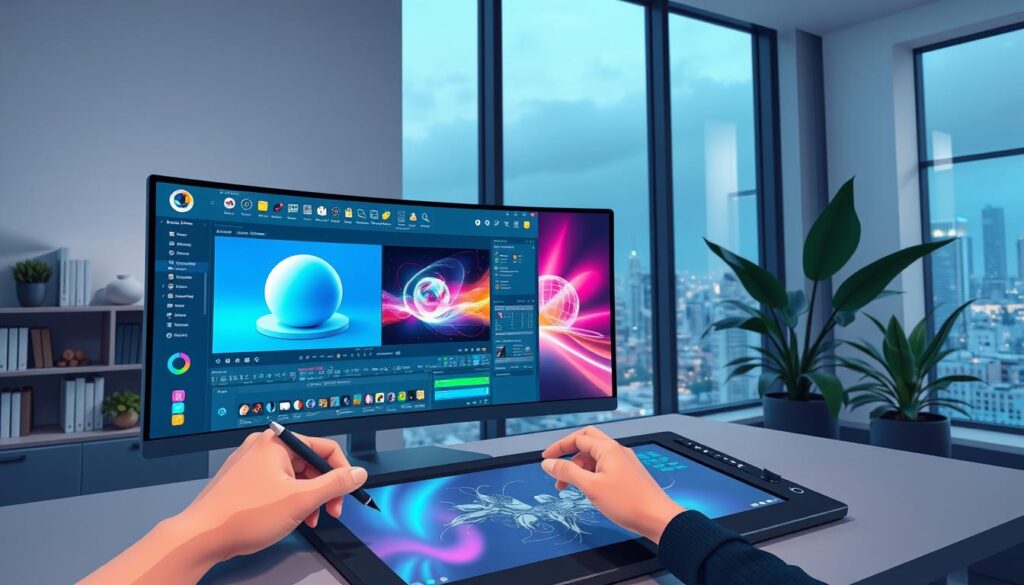Motion graphics is key in telling stories with pictures and sounds. It makes complex ideas easy to understand. Motion graphics mixes graphic design, animation, and sound to make engaging visuals.
With new tech, more people want to work in motion graphics. Learning it opens doors to creative jobs. It’s used in videos and social media, making it vital today.
Key Takeaways
- Understanding the basics of motion graphics and its applications
- Learning the skills required to become a proficient motion graphics artist
- Exploring career paths and opportunities in the motion graphics industry
- Discovering the earning possibilities in motion graphics
- Keeping up with the latest trends and tech in motion graphics
Understanding Motion Graphics: Definition and Importance
Motion graphics are key in today’s digital world. They are used in social media, ads, and more. Knowing about them is vital.
What is motion graphics? It’s about using design and animation to make things seem to move. This includes animated text and logos.
The Difference Between Motion Graphics and Animation
Motion graphics and animation are not the same. Animation is about moving characters or scenes. Motion graphics are about moving graphics like text and logos.
| Feature | Motion Graphics | Animation |
|---|---|---|
| Primary Focus | Graphical elements | Characters or complex scenes |
| Typical Use | Advertising, explainer videos | Storytelling, entertainment |
Key Elements of Effective Motion Graphics
Good motion graphics need visual appeal, clarity, and timing. They should grab your attention and clearly share a message.
Want to learn more? A motion graphics online course is great. It teaches you from the basics to advanced skills.
The Evolution of Motion Graphics in Digital Media
Motion graphics have changed a lot over time. They started as simple animated text. Now, they are complex visuals that grab people’s attention all over the world.
Historical Development of Motion Graphics
Motion graphics began in the early 1900s. Pioneers like Walt Disney and Saul Bass started playing with animated graphics. TV and movies made motion graphics more needed, for titles, ads, and learning programs.
As tech got better, so did motion graphics. This led to the digital effects we see today.
Current Trends and Future Directions
Now, motion graphics are key in digital media. They’re in social media and movies. The shift to remote work has opened up motion graphics career opportunities worldwide. This lets artists work together from anywhere.
Thanks to better software and tools, making top-notch motion graphics is easier than before. This means more jobs for motion graphics artists. It could also lead to better motion graphics salary options.
| Trend | Description | Impact |
|---|---|---|
| Virtual Reality (VR) | Immersive experiences using VR technology | Increased engagement and new storytelling methods |
| Artificial Intelligence (AI) | AI-assisted motion graphics design | Enhanced creativity and efficiency |
| Social Media Integration | Tailoring motion graphics for social media platforms | Broader audience reach and more targeted advertising |
Essential Tools and Software for Motion Graphics
Learning motion graphics needs you to know many software tools. You’ll find both top-notch apps and cheaper options. The right tool depends on your project, your skills, and your budget.
Motion graphics artists use many software tools. Top apps are key for their advanced features.
Industry-Standard Applications: Adobe After Effects and Cinema4D
Adobe After Effects is great for making complex animations and effects. It’s loved for its flexibility and many features, like keyframe animation and plugins.
Cinema4D is a 3D software that works well with After Effects. It’s easy to use and produces high-quality work, making it a top choice for artists.

Free and Budget-Friendly Alternatives: Blender and DaVinci Resolve
Blender is a free option for 3D modeling, animation, and more. It’s perfect for indie artists and beginners because of its wide range of tools.
DaVinci Resolve is another affordable choice, mainly for video editing. It also has tools for color correction, audio, and visual effects, making it great for motion graphics.
Knowing what each tool can do helps artists choose the right software. This way, they can get the best results without spending too much.
How to Learn Motion Graphics: Step-by-Step Guide
For those wanting to enter the motion graphics world, a clear learning plan is key. It mixes creativity with technical know-how. A step-by-step guide helps learners grasp all needed skills to excel in this field.
Building a Strong Foundation in Design Principles
Knowing design basics is vital for making engaging motion graphics. It’s about color theory, typography, and composition. These skills make graphics that grab viewers’ eyes.
Design principles are the core of any motion graphics project. They guide the creative process and ensure everything looks good together.

Mastering Technical Skills and Software
Technical skills are as important as creative ones in motion graphics. Knowing how to use Adobe After Effects and Cinema 4D is essential. These tools are what professionals use, and knowing them well boosts your skill level.
Online tutorials and courses can teach you these technical skills.
Practical Exercises for Skill Development
Getting hands-on is key to improving in motion graphics. Doing practical exercises like simple animations or personal projects solidifies your learning. Joining online forums to share work and get feedback is also helpful.
This hands-on way is essential for growing your skills.
By following this guide, you can build your motion graphics skills step by step. You’ll learn design principles, master software, and gain practical experience. This method not only improves your skills but also prepares you for a career in motion graphics.
Top Learning Resources for Motion Graphics
To master motion graphics, you need to use many learning resources. These resources help both beginners and advanced users. There’s a lot of information out there to improve your skills.
Online Courses and Video Tutorials
Online courses and video tutorials are great for learning motion graphics. Sites like Udemy, Skillshare, and LinkedIn Learning have many courses. These courses are taught by experts in the field.
You can learn about Adobe After Effects and Cinema 4D. These are key programs in the industry.
- Udemy’s motion graphics courses cover beginner to advanced levels.
- Skillshare offers project-based classes that let you work on real-world projects.
- LinkedIn Learning provides video tutorials that dive deep into specific software features.

Books and Written Resources
If you like learning from books, there are many good ones. “Motion Graphics: Principles, Practices, and Processes” is a top pick. It covers the basics and more. Online blogs and websites also offer great tips and insights.
- “The Animator’s Survival Kit” by Richard Williams, though focused on animation, offers valuable principles applicable to motion graphics.
- “Motion Graphics: Principles, Practices, and Processes” provides a thorough overview.
Communities and Forums for Continuous Learning
Being part of communities and forums is great. It keeps you up-to-date and lets you meet other professionals. Sites like Reddit, Discord, and motion graphics forums are very helpful.
| Platform | Description | Benefits |
|---|---|---|
| r/motiongraphics community | Share work, get feedback, and stay updated on industry news. | |
| Discord | Various motion graphics servers | Real-time discussions, collaborative projects, and networking. |
| Motion Graphics Forum | Specialized forums like Motionographer | In-depth discussions, job postings, and resource sharing. |
Using these resources can really boost your motion graphics skills. It also keeps you in the loop with the latest trends.
Creating an Impressive Motion Graphics Portfolio
A good motion graphics portfolio shows your skills, creativity, and style. It’s key for getting noticed by clients and employers in the motion graphics world.
Essential Projects to Include
Choose projects that show your range and skill. Include:
- Client work or projects that show you can meet needs
- Personal projects that show your creativity
- Tutorials or educational content, if you teach
Lee Harrison, a famous motion graphics artist, said, “Your portfolio shows who you are and what you can do. It tells your story and what you love.”
Presenting Your Work Effectively Online
After picking your projects, show them well online. Here are tips:
| Platform | Benefits |
|---|---|
| Behance | Large community, easy to showcase projects |
| Personal Website | Customizable, full control over content |
| Vimeo | High-quality video hosting, professional community |
Make your online portfolio easy to use. Use clear categories and short project descriptions. As motion graphics freelancing gets more competitive, a neat and attractive portfolio stands out.
Focus on quality, variety, and how you present your work. This way, your motion graphics portfolio will clearly show your worth to clients and employers.
What is Motion Graphics? How to Learn and Earn? A Complete Career Roadmap
Starting a career in motion graphics is both thrilling and challenging. But with a clear plan, you can find your way to success. The motion graphics field is growing fast, with many motion graphics career opportunities for creative people. To make the most of these chances, knowing how to learn and earn is key.
Setting Realistic Timeline Expectations
Learning motion graphics takes time and effort. It’s important to set realistic goals for your career. It usually takes a few months to a year to learn the basics, depending on your experience and how much you study. Breaking your learning into smaller steps can keep you focused.
Income Potencial and Salary Ranges
Knowing what you can earn in motion graphics helps with your career planning. Salaries vary based on location, experience, and job type. On average, motion graphics designers make between $50,000 and over $100,000 a year. To earn with motion graphics, you need to create great graphics and also understand the business side, including motion graphics salary trends.
Balancing Creativity with Business Skills
To do well in motion graphics, you need to balance creativity with business skills. It’s important to improve your artistic skills. But you also need to know how to market yourself, talk to clients, and manage projects. This balance helps you make the most of motion graphics career opportunities and build a lasting career.
Monetizing Your Motion Graphics Skills
As a motion graphics pro, knowing how to make money is key. Today, there’s a big demand for great visual content. This means lots of chances for motion graphics pros.
Finding Clients and Job Opportunities
To do well as a freelancer, you must find clients. Sites like Upwork and Freelancer can help. Also, use social media and LinkedIn to find new jobs.
Having a strong online presence is important. Make a professional website to show off your work. Join motion graphics groups online to meet people and learn new things.
Pricing Strategies for Freelancers
Figuring out what to charge is key. Look at what others charge for similar work. Think about your experience, the project’s complexity, and the client’s budget.
| Service | Beginner Rate | Intermediate Rate | Advanced Rate |
|---|---|---|---|
| Motion Graphics Video | $500 – $1,000 | $1,000 – $2,500 | $2,500 – $5,000 |
| Animated Logo | $200 – $500 | $500 – $1,000 | $1,000 – $2,000 |
Building Long-Term Client Relationships
To keep a good freelancing career, build lasting client relationships. Always do great work, meet deadlines, and talk well with clients. Ask for feedback and be willing to make changes to show you care.
By focusing on making clients happy and getting better at what you do, you’ll build a strong name in the field. This will bring you more work and referrals.
Conclusion: Taking Your First Steps in Motion Graphics
First, learn what motion graphics is and why it matters. It’s key in digital media and has grown a lot. It’s used in many fields, like ads and movies.
To get good at motion graphics, you need to learn the tools. Adobe After Effects and Cinema 4D are important. You can find lots of online courses and tutorials to help you.
Looking into motion graphics jobs can be very rewarding. You can work on your own or for a company. Building a strong portfolio and knowing how to price your work are key to success.
Starting a career in motion graphics takes hard work and creativity. Follow the advice in this article to do well in this exciting field.
FAQ
What is motion graphics?
Motion graphics makes things look like they’re moving. It uses graphics, text, and more. It’s used in movies, TV, and online to share info, tell stories, or make things more interesting.
How do I get started with learning motion graphics?
Start by learning about design, color, and telling stories. Then, learn software like Adobe After Effects and Cinema4D.
What are the best online courses for learning motion graphics?
Udemy, Skillshare, and LinkedIn Learning have great courses. They cover all levels, from beginner to advanced.
How can I earn a living with motion graphics skills?
You can work as a freelancer, create content, or be a full-time employee. You can also sell online courses or tutorials.
What are some essential projects to include in a motion graphics portfolio?
Include projects like title sequences, explainer videos, and animated logos. They show your skills and versatility.
How do I price my motion graphics services as a freelancer?
Consider the project’s complexity, time needed, and your experience. Look at what others charge to set your prices.
What are the current trends in motion graphics?
Trends include 3D animation, kinetic typography, and simple designs. Keep up with trends to stay competitive.
Can I learn motion graphics without prior design experience?
You don’t need design experience to learn motion graphics. With hard work and practice, you can master it.






